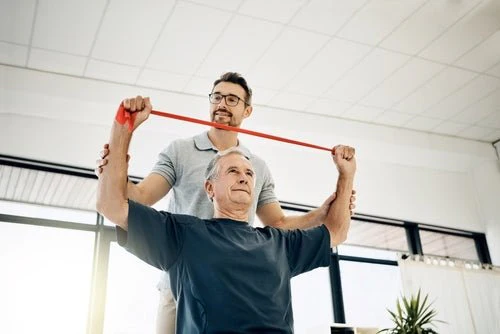
Mobility Training: A Beginner’s Guide
As we get older, our strength and flexibility can begin to deteriorate. This is especially difficult for those with mobility issues or conditions such as arthritis.
But here’s the good news: mobility training can help you stay active, independent, and feel good in your skin no matter your age.
Regular exercise can help ease those creaky joints, improve balance, and keep you steady on your feet.
How is Mobility Training?
Mobility training combines flexibility, strength, and motor control to help your body move smoothly and efficiently.
Flexibility refers to the ability to stretch a muscle when needed, whereas mobility concerns how well you can move and control a joint through its entire range of motion.
For example, if you stand and lift your leg in front of you without using your hands, you’re demonstrating active mobility in your hip joint.
How Does Mobility Training Work?
Mobility training helps maintain joint health, prevent injuries, and enhance overall quality of life. This is especially important as we age, as it helps promote joint lubrication and reduce the risk of injury.
Your nervous system may restrict your range of motion to protect you if it detects that a specific joint is weak or unstable. This is where mobility training comes in.
Engaging in specific workouts that help to strengthen and stabilise your muscles around a joint can teach your nervous system that it’s safe to move freely in certain positions.
The Benefits of Mobility Training
There are many benefits to mobility training for both younger and older adults. This includes:
- Reduced pain and improved joint health: Mobility exercises target tight muscles and stiff joints, helping to release tension and improve motion.
- Enhanced balance and stability: Improved mobility leads to better balance and stability, which is especially crucial as we age. This can help prevent falls and injury.
- Faster injury recovery: Mobility training promotes blood flow and helps flush out waste products from muscles, reducing soreness and stiffness. This is vital for recovery and reduces the risk of injury.
- Increased strength: It enhances muscle activation and strength, aiding with lifting weights, running, or simple daily activities. This also means less effort is required to perform movements like bending, squatting, or reaching.
- Better posture: Mobility training can improve posture by releasing tense muscles and strengthening overstretched or weak areas.
Essential Mobility Exercises for Beginners
To help you get started, here are some quick and simple exercises for beginners:
No Equipment
- Hip circles: Place your feet hip-width apart and, using a controlled motion, slowly rotate one leg in circles from the hip joint. For both legs, make ten circles in each direction.
- Cat-cow stretch: This stretch is excellent for releasing back tension and enhancing spine mobility. Start on your hands and knees, arching your back (cat pose) and then dipping it (cow pose).
- Ankle rolls: This can be done from seated or standing. Rotate each ankle clockwise and anticlockwise for 10 repetitions. This can enhance general lower body stability and prevent ankle sprains.
- Shoulder circles: Stand or sit with a straight back, extend your arms out to the sides, and make small circles with your arms. Gradually increase the size of the circles.
Low Equipment
- Foam roller: This is a fantastic tool for myofascial release, which helps loosen tight muscles and improve circulation. Roll out tight areas like the calves, hamstrings, and back to release muscle knots, reduce soreness, and increase mobility.
- Resistance bands: These are particularly useful for stretching muscles and increasing joint range of motion. Use a resistance band for hamstring stretches or to assist with hip flexor mobility exercises.
- Yoga blocks: Yoga blocks can help modify exercises to suit different flexibility levels. For example, they can be used to elevate the hands during a deep lunge or to support the back in seated stretches.
How to Incorporate Mobility Training into Your Routine
Mobility training doesn’t have to take hours a day. This can be incorporated into your daily routine or around other commitments with the following tips:
- Morning movement: Begin your day with a brief five- to ten-minute exercise regimen. Easy stretches like shoulder rotations, hip circles, and cat-cow stretches can help arouse the body and prepare it for the day.
- Work breaks: Throughout the day, take brief pauses to stretch your hips, do wrist mobility exercises, or roll your ankles. This can help reduce the harmful consequences of extended sitting.
- Warm-ups and cool-downs: To increase flexibility and reduce the risk of injury, include mobility exercises in your warm-up before engaging in more demanding activities and your cool-down afterwards.
Browse Exercise and Recovery Relief with Millercare
Ready to take the next step toward better mobility and pain relief?
Discover Millercare's range of exercise and recovery products, designed to help you stay active, reduce discomfort, and support your overall well-being.
Whether you're looking for knee support, exercise equipment, or other mobility aids, we have everything you need to start moving better today.